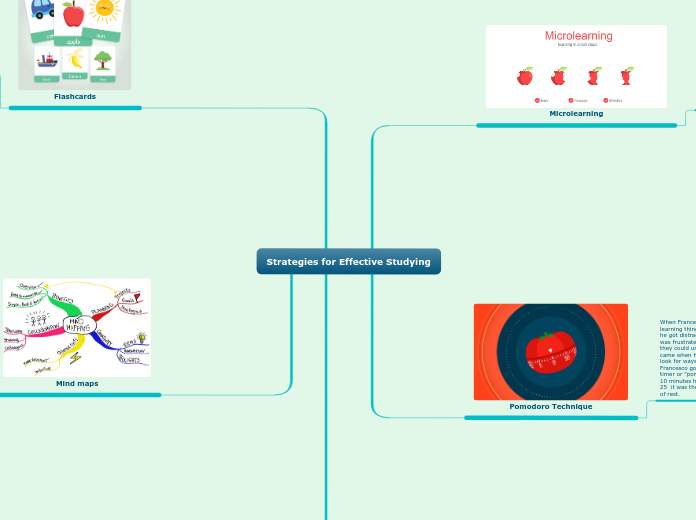Strategies for Effective Studying
MNEMONIC RULES
The word "Mnemotecnia" is derived from the Greek mnéemee (memory), and téchnee (art).
A mnemonic rule is a simple system used to remember a sequence of data, names, numbers, and in general to remember lists of data by relating words, images, etc.
These rules are used on a large scale by young people who have to memorize a lot of information, whether in school or in university, increasing not only their retention capacity, but also their effectiveness by making it easier to obtain information retained in the memory.
There are several rules that help to memorize the required information in a much simpler way than the conventional one, such as:
Rule of the word length.
•Rule of the fable.
•Chain rule.
•First letter rule.
•Rule of invented words.
Mind maps
Mind maps are diagrams or learning tools that help us combine the cognitive functions of the cerebral hemispheres. This strategy helps us understand and memorize concepts faster, based on graphic representations and the association of concepts.
Ideas and concepts are represented by images or symbols and key words. It is very important to use colors to highlight and accentuate ideas, in this way we stimulate our brain to create new connections. The end result is the embodiment of our thoughts, since the elaboration process works just like the human brain: imagining and associating.
Thanks to mind maps we can:
Organize ideas: get an overview of very broad topics in a simple and clear way.
Brainstorm: an initial concept can be developed until arriving at another concept that will finally be the final one.
Flashcards
Are cards with drawings, photos and words that are used to learn new vocabulary in the sense that, for the one face, learn the concepts and for the other face, the development serves to synthesize the most important concepts that are going to be studied and helps memorize the conceptos easy.
Things that must take into account to make a flashcards manually:
• we must use our own cards, that is, make them on our own, synthesizing the information, detecting the most important thing with our own words.
• to make creatively underline with different colors for the better reception.
• Use drawings related to the topic, the drawings are a better form of keep the brain awake since the human being is visual facilitates the memorizing concepts.
•Use just one file for concept.
Pomodoro Technique
When Francesco Cirillo was a student, he had a hard time learning things, he forgot quickly, exam dates were coming, he got distracted very quickly, etc.
was frustrated to see that all his classmates
they could understand but francesco could not, then a moment came when he got tired of being the last of the class so he look for ways to understand and concentrate better so when Francesco goes to the kitchen and finds a tomato-shaped timer or "pomodoro" in Italian, even though he failed the first 10 minutes he tried again until he realized that in the minute 25 it was the ideal time to concentrate, followed by 5 minutes of rest.
There are six steps:
1.-Decide on the task to be done.
2.-Set the pomodoro timer, traditionally to 25 minutes.
3.-Work on the task.
4.-End work when the timer rings and put a checkmark on a piece of paper.
5.-If you have fewer than four checkmarks, take a short break 3–5 minutes, then go to step 2.
6.-ter four pomodoros, take a longer break 15–30 minutes, reset your checkmark count to zero, then go to step 1.
Microlearning
It is a methodology that consists of creating capsules or pills of digital content for your online courses.
there are small training modules with a duration that should not exceed 3 minutes.
Micro-learning is based on the idea that fragmented content is adjusted to the attention span in which the human brain remains focused.
Why use microlearning?
• Effective learning.
• It can be reused.
• High impact.
Create micro learning content
. Ideally, divide the content into 3-minute capsules, for example 1 academic hour.
. The modules must be brief, attractive and essentially visual.
. Never forget the general objective of the course.
Micro learning applications:
• training tool.
• Commercial training.
• easy to update

